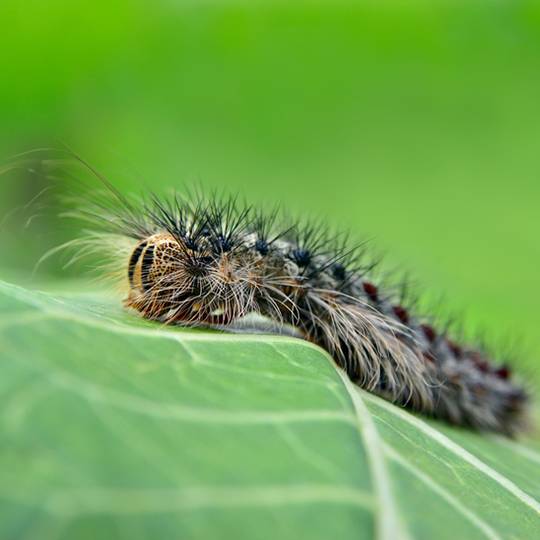
A serious threat to trees and shrubs in North America, the gypsy moth (Lymantria dispar) is an insatiable eater–one fully grown caterpillar can eat up to a square foot of tree leaves in just one day. This defoliation process can significantly damage a tree, and if the infestation is bad enough, strip the entire tree of leaves within a matter of days. Some hardier trees can survive a single attack, but will be weaker and more susceptible to other pests and diseases.
Although these nocturnal noshers find almost any tree to their liking, they prefer to feed on deciduous hardwoods like oak, elm, and maple. Willow, birch, and apple are also favorable for their feasts. Hardwoods, especially oaks, can’t survive consecutive seasons of infestations. Besides seeing the fuzzy looking caterpillars on your trees in the late spring, there are other signs that you may have a gypsy moth problem in your yard.
Signs and Symptoms of the Gypsy Moth
Introduced into North America from Europe during the mid 1800s, the gypsy moth was originally a breeding experiment that went wrong. The plan was to crossbreed it with the silkworm and create a thriving silk industry in the United States. But once outside the lab, this ravenous pest found plenty of trees to feed on and few predators to stop its path of destruction.
Gypsy moths are easy to identify because of their distinct coloring during their four developmental stages—egg, caterpillar (larva), pupa, and adult moth. To determine if you have these destructive pests in your yard here’s what to look for:
- Containing anywhere from 400 to 500 eggs, the moth’s teardrop-shaped egg masses are tan to yellowish, may be hairy in appearance, and can range from approximately 1″ to 1-1/2″ long. They can be found on tree trunks, outdoor furniture, and a home’s siding.
- The larvae, or caterpillars, can reach up to 2-3/4″ long. Their hairy bodies are black or brown and have five pairs of blue bumps toward the front and six pairs of red bumps toward the back.
- The adult moths arrive in the middle of summer. The brown males have antennae and fly, while the females are larger, cream color, and don’t fly.
- Overall, the destruction that these insatiable pests can cause ranges from light leaf damage to branches stripped bare of leaves to a tree’s complete defoliation.
Control and Treatment of Gypsy Moths
Unfortunately gypsy moths are here to stay and the best we can do is to make sure they don’t spread uncontrollably and cause major destruction in our landscape.
Healthy, hardy trees can withstand an attack and even endure a gypsy moth infestation, so the best prevention is taking appropriate care of your trees. Proper watering, fertilization, and pruning can keep you one step ahead of the pests.
The best time to fight off a gypsy moth attack is before they reach the larval stage. If you discover the egg masses in your yard, destroy them immediately by drowning them in kerosene or burning them. You can also use a horticulture oil insect spray in the late fall, which should be followed up in the early spring before the tree leaves develop. There are also devices and ways to treat the tree trunk to prevent the caterpillars from crawling up it to feed on the foliage.
To find out more on how to prevent gypsy moths from defoliating the trees in your yard, contact Elite Tree Care today at 610-935-2279.
Need Help with Gypsy Moths?
Call Elite Tree Care today at 610-935-2279 and let's talk about how we can help you with Gypsy Moths and other Pennsylvania tree pests.
Get a Free Quote